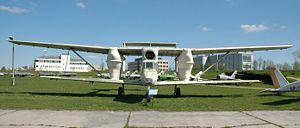- PZL M-15 Belphegor
-
The Mielec M-15 was a jet agricultural aircraft, manufactured by PZL Mielec in Poland for the USSR agricultural aviation. It was the only jet biplane and only jet agricultural plane in the world. For its strange looks and noisy engine it was nicknamed Belphegor after the noisy demon.
 M-15 at Polish Aviation Museum
M-15 at Polish Aviation Museum
Contents
Development
The aircraft was designed in Poland in response to a Soviet requirement for a new agricultural plane to use on great areas of the Soviet collective farms (kolkhoz and sovkhoz), more modern and efficient than the Antonov An-2SKh and An-2R. Poland had already produced the agricultural Antonow An-2R under licence for export back to the USSR, and agricultural planes became a Polish specialization in the Comecon. The Soviet side insisted on using a jet engine in a new plane, and also participated in the design process.
In order to research new problems connected with using the jet engine on a slow agricultural biplane, first an experimental plane Lala-1 for Latające Laboratorium 1 (Polish: Flying Laboratory 1) was built in Poland and flown on 10 February 1972. It used the whole front part of an An-2, with wings, while the rear part was cut off and replaced with a frame construction, housing the Ivchenko-Progress AI-25 jet engine (known for powering the tri-engined Yakovlev Yak-40 and the Aero L-39 Albatros fighter-trainer). [1] The Lala-1 was equipped with agricultural devices. Its tests helped to design the M-15.
The first variant of the M-15 was flown on 30 May 1973, and the second prototype on 9 January 1974. During the next few years it was intensively tested, along with a pre-production series. The M-15 was shown at the Paris Air Show in 1976, where it was nicknamed the "Belphegor" due to its strange look.
Serial production started in 1976. Soviet agriculture planned to order as many as 3,000 aircraft, but the first experiences of M-15 service were disappointing. The jet agricultural plane was not economical, and production ceased in 1981 after 175 aircraft were built. It was only used in the USSR.
Description
The aircraft was a metal twin-boom biplane, with a jet engine over the crew cab. Part of lower wings and chemicals tanks were made of a laminate to avoid corrosion. Upper and lower wings were connected with two thick columns, housing chemicals' tanks, 1450 l (377 US gal) each. Fixed tricycle landing gear. The crew was a pilot; two technicians could be carried if necessary. The M-15 was fitted with spraying and dusting gear, powered with compressed air.
Specifications (M-15)
The data in different sources vary a bit General characteristics
- Crew: 1
- Capacity: two passenger, and up to 2,900 l (770 US gallons) or 2,200 kg (4,850 lb) of chemicals
- Length: 12.72 m (41 ft 9 in)
- Wingspan: 22.40 m (73 ft 6 in)
- Height: 5.34 m (17 ft 6 in)
- Wing area: 67.5 m² (726.5 ft²)
- Empty weight: 3,090 kg (6,812 lb)
- Loaded weight: 5,650 kg (12,456 lb)
- Max takeoff weight: 5,570 kg (12,280 lb)
- Powerplant: 1 × Ivchenko-Progress AI-25 jet, 3,300 lbf (14.8 kN)
Performance
- Maximum speed: 200 km/h (125 mph)
- Stall speed: 89 km/h (55 mph)
- Economical cruise speed: 165 km/h (102 mph)
- Range: 400 km (250 miles)
- Service ceiling: 4,500 m (14,760 ft)
- Rate of climb: 270 m/min (886 ft/min)
- Wing loading: kg/m² (lb/ft²)
See also
- Related development
Yakovlev Yak-40, the series aircraft with the same Ivchenko AI-25 jet.
References
External links
PZL aircraft PZL - up to 1939
(Państwowe Zakłady Lotnicze)PZL: P.1 · Ł.2 · PZL.3 · PZL.4 · PZL.5 · P.6 · P.7 · P.8 · P.11 · PZL.12 (PZL-H) · PZL.16 · PZL.19 · PZL.23 Karaś · P.24 · PZL.26 · PZL.27 · PZL.30 Żubr · PZL.37 Łoś · PZL.38 Wilk · PZL.39 · PZL.42 · PZL.43 · PZL.44 Wicher · PZL.45 Sokół · PZL.46 Sum · PZL.48 Lampart · PZL.49 Miś · PZL.50 Jastrząb · PZL.53 Jastrząb II · PZL.54 Ryś · PZL.55 · PZL.56 Kania ·
CSS / WSK-Okęcie
/ PZL Warszawa-OkęciePZL: PZL-101 Gawron · PZL-102 Kos · PZL-104 Wilga · PZL-105 Flaming · PZL-106 Kruk · PZL-110 Koliber · PZL-111 Koliber · PZL-112 Junior · PZL-126 Mrówka · PZL-130 Orlik · PZL-230 Skorpion
Other produced: WSK Junak · CSS-10 · CSS-11 · CSS-12 · CSS-13 · PZL Jak-12 · MD-12
WSK-Mielec / WSK PZL-Mielec
/ PZL Mielec (Polskie Zakłady Lotnicze)WSK-Świdnik / WSK PZL-Świdnik / PZL-Świdnik WSK PZL-Krosno KR-03
Szybowcowy Zakład Doświadczalny
/ PZL Bielsko-Biała / Allstar PZL GliderSZD-6 · SZD-7 · SZD-8 · SZD-9 · SZD-10 · SZD-11 · SZD-12 · SZD-13 · SZD-14 · SZD-15 · SZD-16 · SZD-17 · SZD-18 · SZD-20 · SZD-21 · SZD-22 · SZD-23 · SZD-24 · SZD-25 · SZD-26 · SZD-27 · SZD-28 · SZD-29 · SZD-30 · SZD-31 · SZD-32 · SZD-33 · SZD-34 · SZD-35 · SZD-36 · SZD-37 · SZD-38 · SZD-39 · SZD-40 · SZD-41 · SZD-42 · SZD-43 · SZD-45 · SZD-48 · SZD-49 · SZD-50 · SZD-51 · SZD-52 · SZD-54 · SZD-55 · SZD-56 · SZD-59
Lists relating to aviation General Aircraft (manufacturers) · Aircraft engines (manufacturers) · Airlines (defunct) · Airports · Civil authorities · Museums · Registration prefixes · Rotorcraft (manufacturers) · TimelineMilitary Accidents/incidents Records Categories:- Polish agricultural aircraft 1970–1979
- PZL aircraft
- Poland–Soviet Union relations
Wikimedia Foundation. 2010.

